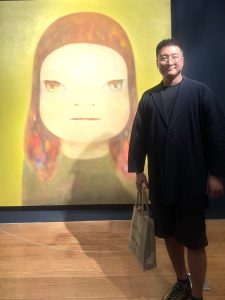Knowledge Exchange

Alumni Talk Business – Art as an Alternative Investment
This month, we sat down with Taka Kang Yao (HKU MBA, Class of 2014) who shared with us his journey into the world of alternative investment, providing invaluable insight into how to navigate this world.

Taka Kang Yao is a professional investor on U.S. and Japan equities, alternative investment including wine, contemporary art and old masters paintings.
Getting into the Alternative Investment Business
“I got into the business of alternative investment through contacts at one particular family office when completing the global track in New York during my MBA. They were looking for new investment ideas and I suggested wine, contemporary art, or the Airbnb business in Japan.
“At first, they were not interested in contemporary art or wine. They had some modern master paintings, but nothing in the way of contemporary art. As such, we started by buying some properties in Japan for an Airbnb business. It went well: we reached up to 20 percent return within three months of operations. Unfortunately, the business stopped abruptly due to new government regulations.
“It was around 2014-15 when I became familiar with the second and third generations of the family. They grew interested in contemporary art and wanted to diversify their portfolio. We went on to buy works from around 100 artists, including renowned Japanese artist, Yayoi Kusama. Today, the value of her art is at least 10 times, some are almost 100 times greater than 10 years ago – it’s one of the best investments we ever made.

“During COVID, there was a common expectation that the market would drop because everything else was: the stock market, property, and even diamond prices. However, artwork was not impacted by the global pandemic. Economic crises seem to have more of an effect on the middle class than on ultra-high-net-worth individuals. Those who buy high-value art may have a hundred billion in net assets and not be significantly affected by a crisis such as COVID. That may explain why when everything else dropped art, at the high end, kept growing.”
Making the Right Purchase
“There are three main parties who give purchasing advice to prospective investors: auction houses, galleries, and art scholars.
“Auction houses are the most approachable since investors are their clients. Historically, they have had a very good set of transaction databases, and their practice is similar to that of a stock market. They explain to clients why a certain artist is popular, along with supporting data. The problem with auction houses, however, is they can only advise on recent trends. They know whether an artist has been popular in the last three years, but this doesn’t mean that this artist will still be in favour in three years. Auction houses provide good insights from a transactional perspective, though it is more quantitative than qualitative. Given my background in fund management and equity research, this logic fallacy seems obvious here.
“The next source of advice is from galleries. We approached the top galleries in the world (most of which are in the U.S.) and sought advice on which artists they believed might increase in value over the next 20 years. Compared to auction houses, galleries can provide more valuable opinions on artists and their artwork. The downside is that each house represents its own select group of well-established and expensive artists, and buying their artworks is akin to buying blue-chip stocks like Tencent or Apple. The art will gain value, but from an investment point of view, the space to grow is limited. You won’t have a return like 20 times but rather like value conservation.

“The third group able to provide advice are art scholars. If galleries give you a perspective in decades, then art scholars give you a perspective in centuries. We have some friends at Columbia University, NYU, UCLA, Berkeley, and various art institutes in Europe.
“Also, the price points up to a certain level, say 10 million dollars, it is no longer about any historical importance or so. An artwork’s value doesn’t solely depend on the piece itself. It matters if it can be placed in front of the right person. If a piece of art can be placed in front of billionaires who resonate with it, they’re willing to bid a high price for the artwork. And that’s why the top-notch works are always sent to auction houses rather than dealt in private hands.”
Trends and Challenges
“Sustainability, as a trend, is being revisited at the moment. I met someone in New York who represents a pioneer artist from the ‘land art’ genre of the 1970s – they only use organic materials from the land.
“NFTs are going to be the future of art. NFTs are not about the art itself but about the copyright of the art. If you help an artist sell their paintings to a collector then the earning potential from that deal is finished. NFTs open up the potential for art to be more like music, where royalties are paid as long as the song is played on the radio or a streaming service.
“Many collectors and businesses are going through a tokenization process now; we are also entertaining the idea to tokenizing our art collection. The SEC in the U.S. changed their regulations last year, creating more opportunities in this area. BlackRock, the world’s largest asset manager, launched a tokenized private equity investment fund a few months ago. However, regulations differ across regions, which presents a challenge to buyers and sellers.
“Another challenge in alternative investments is the upkeep costs for artwork – it’s very expensive. In recent years, the value of art has grown exponentially, and insurance costs are a big issue for asset managers of this kind at the moment.
About the Alumni Business Talk series
In this new series, we sit down with HKU MBA alumni across industries each month to get an insight into current trends in the world of business and their leadership journeys to inspire and empower.










